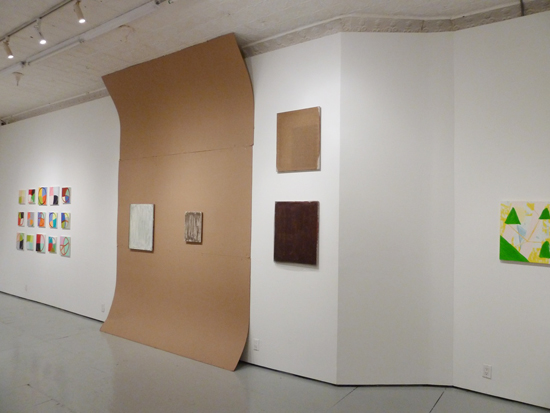
I met this week’s featured artist, Robert Janitz, at Momenta Art in Williamsburg, where he is part of the new exhibition, Winter Break. Janitz grew up in Germany, and honed his artistic practice in France. His relationship to the space reflects this background. He arranges his paintings like installation, employing artificial backdrops made of cardboard. His interventions push as much against the old architectures of Western Europe as they do against the white of contemporary art galleries. When he speaks of the old great halls, and palaces of Europe, there is awe in his voice, though he speaks of tradition as an impossibly binding force.
When I first encountered them, the four paintings included in his show seemed sparse and harshly minimal. Looking closer, I realized each painting functions on a variety of levels. In them we see evidence of process, whether it’s the back of a canvas, or a portion of the stretcher, viewed through a translucent varnished surface. There is a serious level of self reflection in these paintings. This is not merely process painting, or art about art. Though they might speak with a different accent and walk with a strange gate, these are paintings nonetheless. To view Janitz’s work is to join the artist on a circuitous journey. Following him one gets the sense that the artist is searching for a new kind of space, somewhere to create work that is both powerful and approachable.

How do you view your paintings in relationship to their surroundings?
They eat the surroundings. Well, hmmm, let’s see. There’s a current show at Guggenheim “Classicism and Chaos” which i think reflects on skepticism about the architectural framing of art. One would think that a painting would have an autonomy that would be independent of architecture. Scratch that assumption. I walk away from that game entirely.
In relationship to the tradition of painting?
Parasites are quite abundant in a healthy ecosystem. Eliminating cash is getting rid of corruption. Every society needs a black market.
You have lived in New York for about a year and a half, before that you spent several years in Paris. You were raised in Germany. How do you think these shifts have effected your working practice?
It is a cornucopia of inspiration to me, how people enjoy their suffering and how they create their environments/cultures to do so. And they don’t want to be cured. I love New York and New York loves me.

You often utilize materials, such as tulle, unprimed canvas, varnish, and cardboard in your work. There is an often industrial feel to these materials, can you speak to this?
I’d like to tie in the surface issue and the notion of flatness. How in some pieces it is about scraping the surface and in others it’s about shiny, matte, glossy or muted. They provide planes of focus, from behind and in front. For instance the cardboard piece pulls you behind the surface. In a way its size and casualness dilates the focus.
Your paintings seem to subvert traditional notions of painting. Do they function as paintings in the traditional sense? What is it exactly that you are challenging/ negating?
They are a double negation.
How integral is installation to your process?
I envision painting with the canvas hung on the wall and then presenting it laid out flat on a table. When we’re talking about the place of the cardboard I think about the architectural constraints of fucking – or the evolution of the glory hole.
Do you work with an idea or space in mind, or does the final installation come as a secondary consideration?
If you think like a maggot: it would chew through what ever it is in. There is no consideration at all. There is just unmediated action. That is the point of my work.
(images courtesy of the artist)


 RSS
RSS

one of the finest. one of the most subtle. one of the most engaging. one of very, very few left.
January 12, 2011 @ 8:45 pm
my hat’s off to Robert The
January 12, 2011 @ 11:39 pm
I scare. he a bad boy.
January 13, 2011 @ 12:04 am
bien vu robert !
January 13, 2011 @ 12:29 pm
M m m m !
January 19, 2011 @ 9:41 am